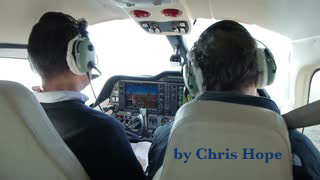So, you’re flying with a friend in their aircraft. Although you have more total time and experience, it is their plane and they have a lot more experience in it than you have. The ATIS is calling for some strong, gusty crosswinds at the destination airport, but you continue, anyway. After a rather scary landing, you say to each other, “I never would have done that by myself, but I figured you knew what you were doing.” Hmm.
Or maybe this: Your buddy is flying from the left seat, when you notice that he seems engrossed in his iPad. You notice the plane has wandered off course and altitude a bit, so you nudge it back to wings-level. Your partner notices, but doesn’t say anything. After a while, you again notice it’s off, and you correct again. Then, a few minutes later Center asks if you are on the heading and altitude you really want. And the two of look at each other and say, “I thought you were flying.”
Here’s another one: maybe most pilots don’t know that a flight instructor without a current medical can still administer a flight review. The FAA, in a bit of logic understood by no one, maintains that flight instruction is totally separate from…flying. And using this logic, a CFI can exercise the privileges of his CFI certificate even though he might not be legal to exercise the privileges of his pilot certificate. Under this thought process, a CFI can give instruction as long at the person receiving instruction can legally act as Pilot-in-Command (PIC). This scenario usually comes into play when a pilot, still within his 24-month flight-review window, asks for a flight review. Under th0se circumstances, the CFI can conduct the review.
This was the situation that one CFI saw. A pilot he knew asked for a flight review, and he knew that he personally could not act as PIC. The pilot knew that the CFI did not have a current medical, but he did not consider the ramifications further. The CFI knew that the pilot knew that he did not have a medical, but he assumed that the pilot was legally current in the plane. Both thought the other was PIC. OOPS!
According to FAR 1.1:
Pilot in command means the person who:
(1) Has final authority and responsibility for the operation and safety of the flight;
(2) Has been designated as pilot in command before or during the flight; and
(3) Holds the appropriate category, class, and type rating, if appropriate, for the conduct of the flight.
Note that nothing in this definition relates to actually manipulating the controls.
FAR 61.51, on the other hand, deals with logging PIC time, and it states in part, that a person can do so:
(e) (i) When the pilot is the sole manipulator of the controls of an aircraft for which the pilot is rated, or has sport pilot privileges for that category and class of aircraft, if the aircraft class rating is appropriate;
So there is a bit of conflict between who logs PIC time, and who acts as PIC. For the purpose of this discussion, let’s concentrate on “Who’s in charge here?”
First of all, who has “the final authority”, and who has been “designated as pilot in command?” I think that when two pilots fly together, the topic does not usually come up, because one or both are embarrassed to bring it up. After all, when you declare who is PIC, that’s who will be responsible to the FAA and the insurance company when things go wrong. And secondly, you are agreeing that in an emergency, one of you will be telling the other what to do. Could be touchy.
I often see the situation myself when I fly as an instructor in my student’s plane. We decide the PIC question on a case-by-case basis. If my student is legally qualified to act as PIC, and we both feel that he is competent to act as PIC, generally we agree that he will be PIC. If, on the other hand, I am conducting a checkout or a flight review for a pilot who is really not comfortable with acting as PIC, I will take on that role. (And whenever I fly another person’s plane, I ensure that I am covered to act as PIC by his insurance.) In either case, before we walk out to the plane together, we settle the question. Note that establishing who is PIC does not mean that the non-PIC is supposed to sit back and be a spectator when the situation deteriorates. But the designated PIC is the final authority on the course of action. Need to swap roles in flight? No problem. Just make sure that both of you agree.
Then, there is the question of who is actually in charge of manipulating the controls, and this can be the occupant of either front seat. Obviously, the person who is actually flying needs to be qualified to do so, but again, both of you need to agree on this. A simple solution – This conversation:
“Would you take the plane for a minute?”
“Sure. I’ve got it.”
“Right. You have the plane.”
Then, when you are ready to take the plane back:
“OK, I’ve got the plane again.”
“Roger, you have the plane”
“I have it.”
A little communication goes a long way. Go Forth. Fly safe. Have fun.
Chris Hope has taught flying for more than 40 years. He holds flight instructor certificates for single-engine land and sea airplanes and multi-engine land planes, as well as for instrument training. He holds ground instructor certificates for advanced and instrument training. Chris is an FAA Gold Seal Instructor and a Master Certified Flight Instructor and is the 2015 National FAASteam representative of the year. Find him at:. www.ChrisHopeFAAFlightInstructor.com.

